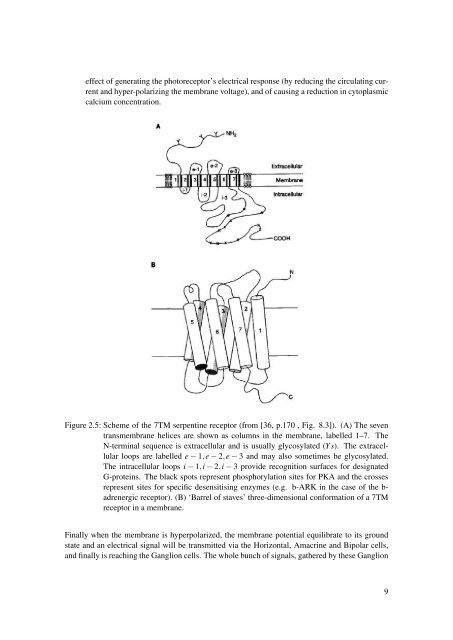- Page 1: Diploma ThesisDepartment for Theore
- Page 5 and 6: AbstractAnomalous diffusion is a ub
- Page 7 and 8: Zusammenfassung 1Anomale Diffusion
- Page 9 and 10: Contents1 Motivation 12 Visual Tran
- Page 11 and 12: List of Figures2.1 Anatomy of the e
- Page 13 and 14: 1 Motivation„NEC FASCES, NEC OPES
- Page 15 and 16: Theoretically we profit from enormo
- Page 17 and 18: 2 Visual Transduction”The eye owe
- Page 19: (a)(b)(c)Figure 2.3: (a) The anatom
- Page 23 and 24: 3 Theory”The theory is the net, t
- Page 25 and 26: 3.2 Markov Chains, Markov Processes
- Page 27 and 28: 3.2 Markov Chains, Markov Processes
- Page 29 and 30: 3.2 Markov Chains, Markov Processes
- Page 31 and 32: 3.3 Hidden Markov ModelsP[X(t + τ)
- Page 33 and 34: 3.4 Maximum Likelihood Principlewit
- Page 35 and 36: 3.5 Optimization3.5 OptimizationAcc
- Page 37 and 38: 3.7 Baum-Welch-AlgorithmAlgorithm 3
- Page 39 and 40: 3.8 Two Approaches on Stochastic Sy
- Page 41 and 42: 3.9 DiffusionConsider a basin fille
- Page 43 and 44: 3.9 Diffusion169].Rearranging (3.34
- Page 45 and 46: 3.9 Diffusionwith τ = t −t ′ .
- Page 47 and 48: 3.9 DiffusionD = 2k2 B T 2σ . (3.4
- Page 49 and 50: 3.10 Hidden Markov Models with Stoc
- Page 51 and 52: 3.10 Hidden Markov Models with Stoc
- Page 53 and 54: 3.10 Hidden Markov Models with Stoc
- Page 55 and 56: 3.11 Hidden Markov Model - Vector A
- Page 57 and 58: 3.11 Hidden Markov Model - Vector A
- Page 59 and 60: 3.12 Artificial Test Examples for H
- Page 61 and 62: 3.12 Artificial Test Examples for H
- Page 63 and 64: 3.12 Artificial Test Examples for H
- Page 65 and 66: 3.12 Artificial Test Examples for H
- Page 67 and 68: 3.12 Artificial Test Examples for H
- Page 69 and 70: 3.13 Global Optimization Methods3.1
- Page 71 and 72:
3.13 Global Optimization MethodsEve
- Page 73 and 74:
4 Fluorescence Tracking Experiments
- Page 75 and 76:
4.2 Fluorescence SpectroscopyAfter
- Page 77 and 78:
4.3 Single Molecule Tracking via Wi
- Page 79 and 80:
4.4 Total Internal Reflection Fluor
- Page 81 and 82:
4.4 Total Internal Reflection Fluor
- Page 83 and 84:
4.6 The expected range for the Tran
- Page 85 and 86:
5 Modeling of the Experiment”The
- Page 87 and 88:
5.1 Experimental Data(a)(b)(c)(d)Fi
- Page 89 and 90:
5.2 Model Ansatz and Estimation of
- Page 91 and 92:
5.2 Model Ansatz and Estimation of
- Page 93 and 94:
5.3 Testing the Modelalgorithm was
- Page 95 and 96:
5.5 Estimation of the Noise Intensi
- Page 97 and 98:
5.6 Estimation on the Basis of Diff
- Page 99 and 100:
5.6 Estimation on the Basis of Diff
- Page 101 and 102:
5.6 Estimation on the Basis of Diff
- Page 103 and 104:
6 Conclusion and OutlookThe main as
- Page 105 and 106:
7 Bibliography[1] R. C. Aster, B. B
- Page 107 and 108:
[36] C. U. M. Smith: Elements of Mo
- Page 109 and 110:
Index11-cis retinal isomer, 87TM se
- Page 111 and 112:
A AppendixA.1 From Copernicus to Ne
- Page 113 and 114:
A.2 Important Papers on the Rhodops
- Page 115 and 116:
A.3 Probability TheoryDefinition A.
- Page 117 and 118:
A.4 Definitions for OptimizationDef
- Page 119 and 120:
A.4 Definitions for OptimizationDef
- Page 121 and 122:
A.7 The Fluctuation-Dissipation-The
- Page 123 and 124:
A.7 The Fluctuation-Dissipation-The
- Page 125 and 126:
A.8 Kramers-Moyal Forward Expansion
- Page 127 and 128:
A.9 Deriving the Fokker-Planck Equa
- Page 129 and 130:
A.9 Deriving the Fokker-Planck Equa
- Page 131 and 132:
DanksagungenIch möchte folgenden M
- Page 133:
AffirmationHereby I, Arash Azhand,









